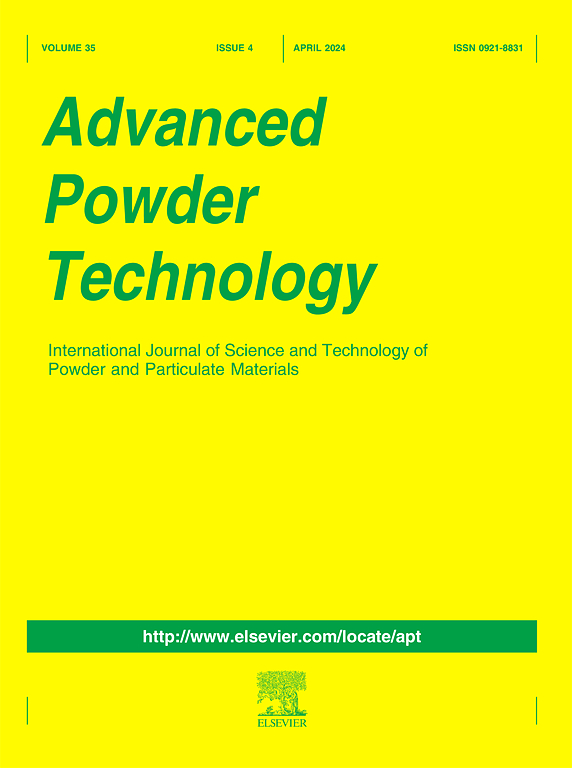Coarse-grained DEM simulation for mixing and segregation of binary-sized particles
IF 4.2
2区 工程技术
Q2 ENGINEERING, CHEMICAL
引用次数: 0
Abstract
While the Discrete Element Method (DEM) are promising tools for analyzing and predicting powder mixing and segregation, the DEM simulation of large-scale powder handling processes remains computationally challenging. To address this issue, we developed a Coarse-Grained (CG) method for granular shear flow (CGSF). Considering the CGSF has been applied exclusively for monodisperse particles with homogeneous particle sizes, an extended CG model for particles with inhomogeneous properties under a granular shear flow is required. As segregation progresses, microscopic particle mixing and segregation can occur on a smaller scale than the CG particle size. Hence, a new method is proposed by which the composition of the original intra-CG particles can change dynamically. Consequently, we propose a coarse-grained model for powder mixing and segregation under dense granular shear flow by extending the CGSF to a binary-sized particle system and developing a method for estimating the microscopic mixing and segregation of the original particles based on the Dynamically Changing Composition (DCC) of the original particles. Using the extended CGSF with DCC, we simulated the powder mixing and segregation of binary-sized particles in a rotating drum, with the performance of the proposed model evaluated in terms of powder mixing, segregation behavior, and computing speed.

二元颗粒混合和偏析的粗粒度DEM模拟
虽然离散元法(DEM)是分析和预测粉末混合和分离的有前途的工具,但大规模粉末处理过程的DEM模拟在计算上仍然具有挑战性。为了解决这一问题,我们开发了一种颗粒剪切流(CGSF)的粗粒度(CG)方法。考虑到CGSF仅适用于颗粒尺寸均匀的单分散颗粒,因此需要一个扩展的颗粒剪切流下非均匀颗粒的CG模型。随着偏析的进行,微观颗粒的混合和偏析可以在比CG粒径更小的尺度上发生。因此,提出了一种可以动态改变原cg内粒子组成的新方法。因此,我们提出了致密颗粒剪切流下粉末混合和偏析的粗粒度模型,将CGSF扩展到二粒径颗粒系统,并开发了一种基于原始颗粒动态变化成分(DCC)估计原始颗粒微观混合和偏析的方法。利用扩展的CGSF和DCC,我们模拟了二元颗粒在旋转滚筒中的粉末混合和偏析,并从粉末混合、偏析行为和计算速度方面评估了所提出的模型的性能。
本文章由计算机程序翻译,如有差异,请以英文原文为准。
求助全文
约1分钟内获得全文
求助全文
来源期刊

Advanced Powder Technology
工程技术-工程:化工
CiteScore
9.50
自引率
7.70%
发文量
424
审稿时长
55 days
期刊介绍:
The aim of Advanced Powder Technology is to meet the demand for an international journal that integrates all aspects of science and technology research on powder and particulate materials. The journal fulfills this purpose by publishing original research papers, rapid communications, reviews, and translated articles by prominent researchers worldwide.
The editorial work of Advanced Powder Technology, which was founded as the International Journal of the Society of Powder Technology, Japan, is now shared by distinguished board members, who operate in a unique framework designed to respond to the increasing global demand for articles on not only powder and particles, but also on various materials produced from them.
Advanced Powder Technology covers various areas, but a discussion of powder and particles is required in articles. Topics include: Production of powder and particulate materials in gases and liquids(nanoparticles, fine ceramics, pharmaceuticals, novel functional materials, etc.); Aerosol and colloidal processing; Powder and particle characterization; Dynamics and phenomena; Calculation and simulation (CFD, DEM, Monte Carlo method, population balance, etc.); Measurement and control of powder processes; Particle modification; Comminution; Powder handling and operations (storage, transport, granulation, separation, fluidization, etc.)
 求助内容:
求助内容: 应助结果提醒方式:
应助结果提醒方式:


